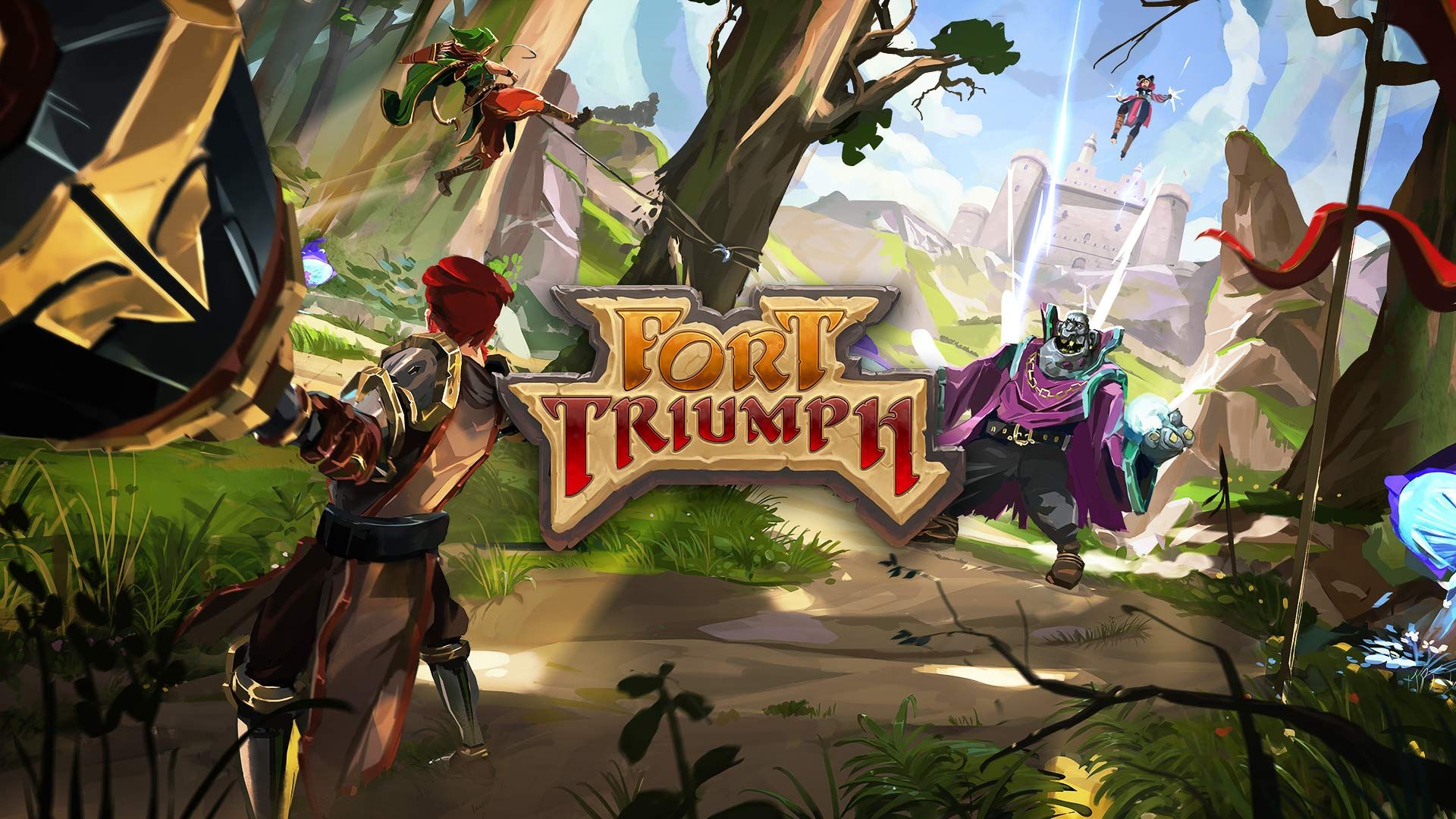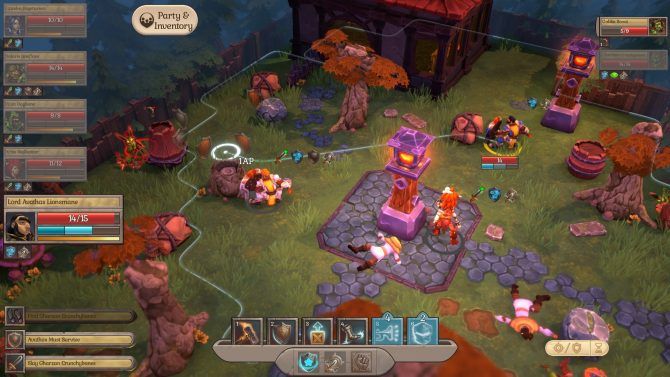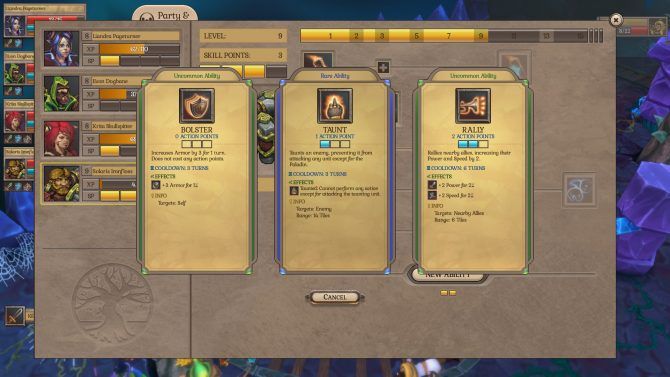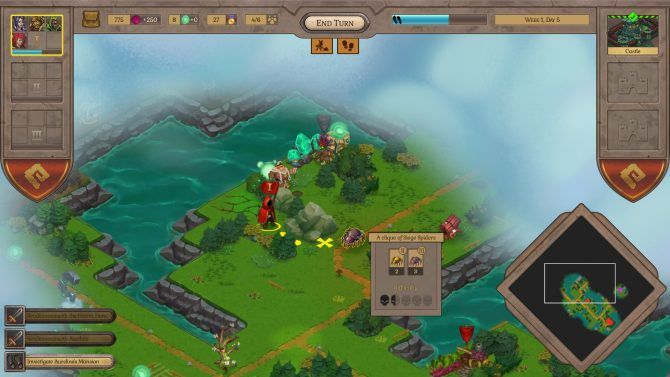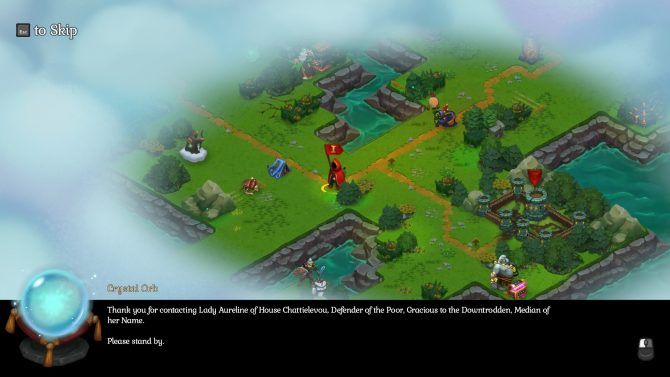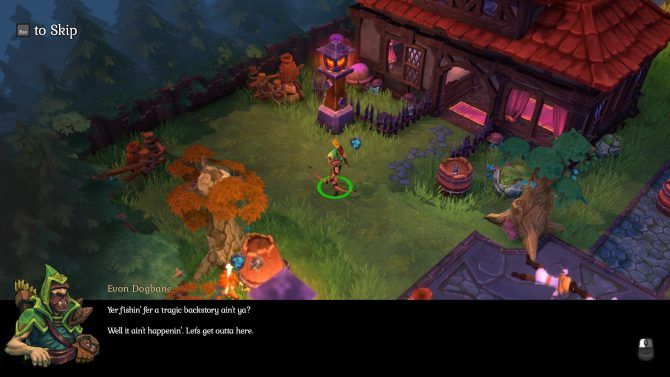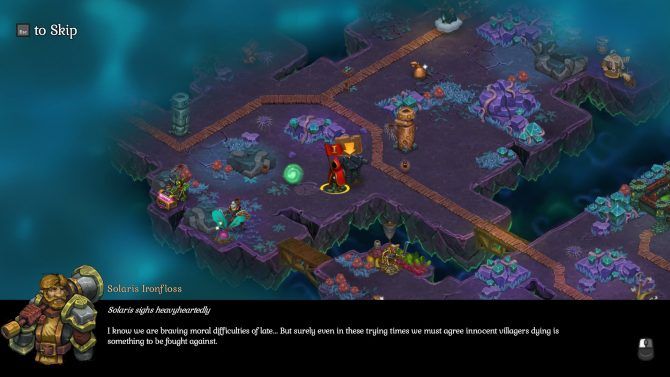Fort Triumph is a tough one for me to review. It does everything it set out to do and has some rock-solid ideas conceptually. Imagine a strategy game like Heroes of Might and Magic, but replacing the massed army combat with fantasy XCOM. The combination works well, and Fort Triumph borrows strongly from both parts to make something reasonably complete. But when all was said and done, I just found myself completely unable to particularly care for it. It should’ve been something I adored, on paper, and I suspect that others will get more from it. I just found nothing to cling to, though.
[pullquote]"But when all was said and done, I just found myself completely unable to particularly care for [Fort Triumph]."[/pullquote]
Tactical battles are the heart of Fort Triumph. You’re presented with a grid-based field to which your party of heroes are deployed, then take turns moving your armies. Each character gets three action points which can be used in any order and combination. Moving will cost one point up to your range, but you can spend more to move further. Most abilities and attacks will cost two to use, barring a few exceptions. So you’ll move, attack, etc. until all your characters have expended their action points, then your turn is over and the enemy moves. Fairly straightforward.
The physics are the most unique draw to Fort Triumph’s battles. Much like XCOM, standing next to objects of various heights can give either half or full cover from attacks in that direction, making you tougher to hit or damage. In Fort Triumph, every character has at least one “physics” ability that can directly interact with objects, whether they be units or cover. If an object or unit gets moved by these and strikes something else, it’ll do damage and stun them for the next turn, making them unable to use abilities. This quickly becomes the best way to manage enemies and keep them from overwhelming you.
This definitely makes for a less defensive approach to battles than XCOM. Cover is now a weapon that can be turned against you, so hiding behind a pillar will usually see it falling on you for huge damage instead. As such, I tended to play fast and direct, setting up chain stuns by pinballing objects between each other and controlling the field of battle. It’s a pretty neat idea, and definitely a good way of differentiating Fort Triumph from the crowd. This also makes sense, given that it was one of the key features of the original Kickstarter.
[pullquote]"Cover is now a weapon that can be turned against you, so hiding behind a pillar will usually see it falling on you for huge damage instead."[/pullquote]
Throughout the course of a game, you’ll build a party from any combination of four character classes: Mage, Paladin, Archer, and Barbarian. They play largely to their archetypes, gaining skill points as you level up. These skill points can be spent either learning new abilities, or upgrading the existing ones. Choosing a new ability will give you a choice out of three, with the order in which skills appear being random (and occasionally cross-class skills being an option). In theory, this keeps your characters varied in between playthroughs or squads. In practice, I couldn’t help but feel like my characters were becoming a homogenous blob. There were other factors to that though, like the story; we’ll get to that.
Between battles, you’ll be presented with a map that’s lifted almost directly from Heroes of Might and Magic 3. Parties have a set amount of movement per turn, which you can use to traverse across the map and interact with the objects you’ll find there. Some grant you items or resources, others are battles with treasure stashed behind them. Ultimately, it serves as a means of getting into more fights and accumulating experience before throwing your parties at the enemy team, who is doing exactly the same.
Bolstering this are the cities and “farms” you’ll find. Claiming a city lets you spend the resources you’ve accumulated on buildings, upgrades, and new heroes or parties. You can maintain up to three parties, but this is a risk, as the encounters on the world map won’t respawn. It can be hard to effectively level up all of them. As for buildings, you can construct up to one per turn, and space is limited so you can’t gain everything. These will generally grant your units some kind of bonus, increase your resource generation, produce more defenders if the city is attacked, and so on.
The buildings you have available are determined by your faction. There are four available, but as each of them have the same hero classes, these building abilities (and aesthetics) are the only real difference. I didn’t encounter any faction-specific skills for the heroes, so this seems to be a fairly minor feature at best.
Unfortunately, I found the overworld map to be fairly lackluster. The encounters are numerous and are usually only there to grind levels on. Challenge is minimal for most, unless you’re trying to level up a secondary party. Some of the items that can be found can change up your party capabilities quite extensively, but those are few and far between. Without the variety of units, armies, or options that something like Heroes of Might and Magic provided, Fort Triumph’s maps feel like little more than a shallow homage.
This is made all the worse by the enemy AI seemingly not playing the same game as me. They seemed to have no problem spawning pre-leveled enemies without regard to the cost. Did I beat up one of their roaming bands? It’s fine, they’ll deploy another a turn later. Losing my main party could seriously slow me down or see all my progress grind to a halt. If I’d already cleared the easy battles on the map, good luck to me.
Thankfully, that didn’t happen often because the AI also doesn’t seem to utilise the physics system well. There’d occasionally be minor attempts, but nothing like the coordinated map manipulation and stun locking I was doing. Maybe this would change on higher difficulties, but given that I was already disadvantaged in resources and party spawns, I didn’t care to find out.
Fort Triumph’s campaign will start you with a party of three adventurers -- Mage, Paladin, Archer -- and your first objective will be to meet the Barbarian. From there, you’ll travel the map as new objectives are placed on it, culminating in you defeating the opposing group in their city. Act completed, and on to the next. You can keep the leveled “story” units and a single artifact or boon to the next stage.
[pullquote]"Without the variety of units, armies, or options that something like Heroes of Might and Magic provided, Fort Triumph’s maps feel like little more than a shallow homage."[/pullquote]
Story in Fort Triumph is extremely lacking. Most cutscenes and moments are little more than a chance to apply some tongue-in-cheek humour that, for me, missed more than it landed. The notion of pointing out the fantasy stereotypes and then subverting them or laughing about them doesn’t make them less cliched. In fact, a lot of mid-budget fantasy games seem to use this instead of actually telling their own story; just try and evoke Dungeon Keeper’s humour but do little else, to the point where such attempts seem more common than the stereotypes.
In fairness, Fort Triumph did start making an attempt in Act 2 and onward. It started interspersing the jokes with attempts at moral quandaries, cynical statements on the way the nobles mistreat their peasants, and so on. Still, it was delivered amidst all the humour that made it really hard to want to take anything seriously.
This was even further hampered by the realisation that cutscenes specifically require a representative of each class to be present. They don't need the individual characters, mind you; any old class member will do. Say the primary Paladin in your group was split from the party (or killed) prior to starting a story mission. No problem: the game will throw a level 1 Paladin into your party to fill in their lines. At that point, it’s kind of impossible to feel for said Paladin’s crisis of faith at learning of their order's corruption when they aren't the same character who discovered it. There was no attachment from that point onward for me.
There’s not much to say about Fort Triumph on the presentation front, either. The graphics are colourful and crisp, but don’t really have anything to make them stand out. Sounds are generic but effective, while the music is very limited and started growing repetitive extremely quickly.
Aside from the campaign, you can set up skirmish matches against the AI, or set up hotseat local co-op against them. There’s no online functionality, though Steam’s remote local play is enabled for it.
[pullquote]"Fort Triumph is a perfectly serviceable game built on an interesting blend of concepts."[/pullquote]
So to summarise, Fort Triumph is a perfectly serviceable game built on an interesting blend of concepts. It just ultimately feels too shallow and uninteresting for me to find anything worth attaching to. Battles are entertaining, but quickly become grindy. There’s a lack of variety in the hero classes, even with their skill customisation; there’s no real cosmetic customisation beyond colours and gender, either.
I almost feel bad that I walked away from it with such a negative sentiment. This clearly meant something to the team, but I just found it dull before too long. Perhaps there’s someone out there who will absolutely adore this game and praise it as a hidden gem.
Still, when you’re based so heavily on a fusion of two very good games, you really need to iterate on those ideas. There has to be something about the combination that stands out; otherwise, people will just compare you to your inspiration and end up going right back to those games. On that note, I just want to play more XCOM now.

